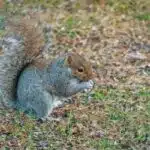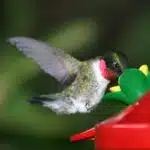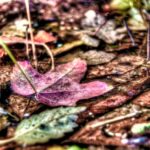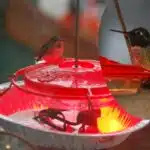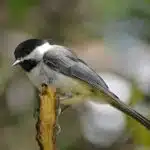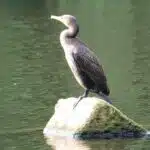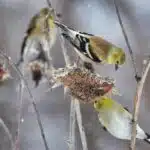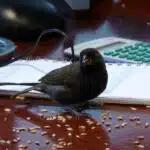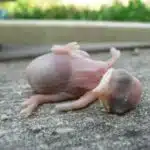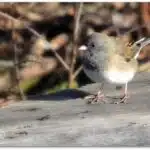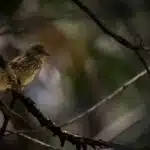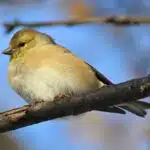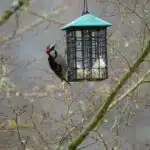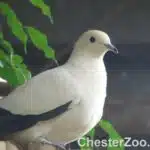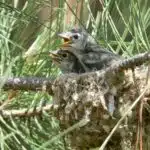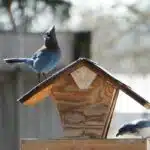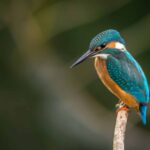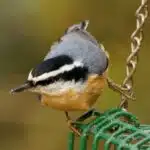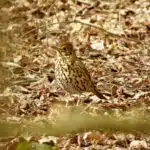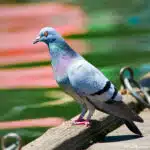As a bird feeder cleaning expert, I have often witnessed the mess that accumulates underneath bird feeders. While bird feeders provide birds with a source of food and entertainment, they also attract squirrels, rodents, and other pests that leave behind debris and droppings. Cleaning up under bird feeders is essential not only for the health and safety of the birds but also for maintaining a clean and attractive outdoor space.
Cleaning under bird feeders may seem like a daunting task, but with proper techniques and tools, it can be done efficiently. In this article, I will share my expertise on how to clean under bird feeders effectively. From identifying potential risks to using eco-friendly cleaning products, this guide will help you create a safe and welcoming environment for birds while keeping your outdoor space tidy.
Understanding The Importance Of Cleaning Under Bird Feeders
Cleaning under bird feeders is an essential task that every bird feeder owner should undertake. While it may seem like a tedious and time-consuming chore, the benefits of cleaning under bird feeders are numerous. First and foremost, it helps to maintain a safe and healthy feeding environment for birds. Dirty feeding areas can attract unwanted pests such as rodents, which can carry diseases that are harmful to both birds and humans.
Moreover, cleaning under bird feeders also ensures that the feeding area remains free of mold and mildew. These fungi thrive in warm, humid environments, making bird feeders an ideal breeding ground. When left unchecked, they can cause respiratory problems in birds and even lead to death in extreme cases. By regularly cleaning under the bird feeder, you can eliminate any potential health hazards.
If you’re looking to attract more birds to your backyard while maintaining a safe feeding environment for them, there are several tips you should keep in mind. Firstly, ensure that you position your bird feeder away from any potential risks or hazards such as windows or doors where birds could collide with them. Additionally, consider providing a covered area for the feeder where birds can take shelter from predators or inclement weather.
Identifying potential risks and hazards when cleaning under bird feeders is crucial to ensuring that the process is carried out safely and efficiently. In the next section, we will discuss some common risks associated with cleaning under bird feeders and how to mitigate them effectively.
Identifying Potential Risks And Hazards
Understanding the importance of cleaning under bird feeders is crucial to maintaining a healthy environment for both birds and humans. However, identifying potential risks and hazards in this area is equally important. As a bird feeder cleaning expert, I have seen many common dangers that can arise from neglecting the area under bird feeders.
One of the most common dangers is the accumulation of mold and bacteria in damp areas under bird feeders. This can lead to health hazards for both birds and humans alike. Prevention tips include regularly cleaning up any spilled food or debris under the feeder, using a rake or broom to remove any buildup of leaves or standing water, and avoiding overfilling the feeder.
Another danger to be aware of is attracting other unwanted animals such as rodents or insects. These pests can carry diseases that are harmful to both birds and humans. To prevent this, it is essential to clean up any spilled seed or debris promptly, use a squirrel-proof feeder if necessary, and dispose of waste properly.
To ensure a safe environment for both birds and humans, it’s essential to prepare the right tools and equipment before starting your cleanup process. In the next section, we will discuss how to choose the appropriate tools for cleaning under bird feeders effectively. Remember always to prioritize safety when dealing with potential hazards around bird feeders!
Preparing The Right Tools And Equipment
To clean under bird feeders effectively, it is essential to prepare the right tools and equipment beforehand. Start by choosing appropriate attire that will protect you from any debris or droppings while cleaning. Wear gloves to avoid direct contact with the cleaning agents and a mask to protect yourself from inhaling any dust particles.
Selecting effective cleaning agents is also crucial. Choose a detergent that can break down organic material and disinfect the area thoroughly. Consider using a mixture of water and vinegar as an alternative to harsh chemicals that may harm birds or other animals in your yard. Additionally, ensure that you have enough cleaning supplies such as sponges, scrub brushes, and spray bottles for easy application.
Cleaning under bird feeders may seem like a daunting task, but with proper preparation and equipment, it can be done efficiently. By choosing appropriate attire and selecting effective cleaning agents, you can create a safe environment for both birds and humans alike. In the next section, we will discuss how to remove debris and droppings effectively without harming the bird feeder or its surroundings.
Removing Debris And Droppings
Bird feeder hygiene is crucial for ensuring the health and safety of birds that come to feed. However, the area underneath bird feeders often accumulates debris and droppings, which can be harmful to both birds and humans. Therefore, it is essential to regularly clean this area to maintain outdoor sanitation and prevent the spread of diseases.
To remove debris and droppings under bird feeders, start by wearing protective gloves and using a rake or shovel to gather larger items. Dispose of these materials in a sealed bag or container, as they may contain harmful bacteria or parasites that can spread disease. Next, use a stiff-bristled brush or broom to sweep away any remaining debris.
After removing all visible waste, thoroughly clean the area with hot soapy water. This will help disinfect the surface and eliminate any remaining bacteria or germs. Rinse the area with a hose or bucket of clean water until all soap residue is removed. Be sure to allow time for the surface to dry completely before allowing birds back into the feeding area.
Proper bird feeder hygiene is an important aspect of maintaining outdoor sanitation and promoting bird health. By removing debris and droppings from under bird feeders on a regular basis, you can help prevent the spread of disease among birds while also keeping your outdoor space clean and safe for humans. In the next section, we will discuss how using eco-friendly cleaning products can further promote healthy outdoor environments for our feathered friends.
Using Eco-Friendly Cleaning Products
After removing debris and droppings from under bird feeders, it’s time to move on to the next step: cleaning with eco-friendly solutions. Using natural cleaning products has many benefits for both the environment and your own health. Traditional cleaning chemicals can be harmful to birds and other wildlife, as well as causing respiratory problems for humans who inhale them. Eco-friendly solutions are gentler on the environment and safer for everyone involved.
One of the main benefits of natural cleaning products is that they don’t contain harsh chemicals that can harm plants or animals in the area. Birds may come into contact with any leftover residue from traditional cleaners, which can be toxic if ingested or cause skin irritation if it comes into contact with their feathers. Natural cleaning products are made from plant-based ingredients that break down naturally over time without causing harm to the surrounding ecosystem.
Another benefit of using eco-friendly cleaning solutions is that they’re better for your own health as well. Traditional cleaners often contain strong chemicals that can cause respiratory issues or skin irritation if you come into contact with them frequently. By switching to natural alternatives, you’re reducing your exposure to harmful substances while still getting a clean result. Plus, many natural cleaners have pleasant scents that aren’t overwhelming like some chemical-based ones.
When it comes to scrubbing hard-to-reach areas under bird feeders, there are a few things to keep in mind. First, make sure you’re using an appropriate tool for the job – a long-handled scrub brush or small handheld brush may be necessary depending on how tight the space is. Second, use a gentle but effective cleaner that won’t damage any surfaces or harm any nearby wildlife. Finally, take care not to disturb any nests or eggs that may be hidden in the area while you’re cleaning – this will help ensure a safe and healthy environment for all creatures involved.
Scrubbing Hard-To-Reach Areas
As a bird feeder cleaning expert, I know that scrubbing hard-to-reach areas can be tricky but it is necessary for keeping the area clean and hygienic. One technique that works well is to use a long-handled brush to reach underneath the feeder. This accessory tool makes it easier to scrub away any debris or bird droppings that have accumulated in the area. Another technique is to use a spray bottle filled with water and vinegar solution to moisten the area and then scrub it with a stiff-bristled brush.
Cleaning techniques are important for maintaining the health of birds that visit your feeder. When bird droppings accumulate in hard-to-reach areas, they can attract pests such as rats and mice, which can carry diseases harmful to humans and birds alike. These pests can also damage your feeder or other outdoor structures in your yard. Therefore, regular cleaning of the area underneath your bird feeder is necessary.
To ensure you are effectively cleaning all areas under your bird feeder, try different accessory tools such as sponges or scrapers that can help you get into tight spaces. Remember to wear gloves when cleaning as bird droppings may contain bacteria or parasites harmful to humans. With these techniques and tools, you will be able to keep your bird feeding area clean and safe for both birds and humans alike.
Transitioning into the subsequent section about disinfecting the area: In addition to using these cleaning techniques and accessory tools, it is also important to disinfect the area under your bird feeder regularly.
Disinfecting The Area
- Regularly sanitizing bird feeders is key to preventing the spread of disease amongst birds.
- Disinfecting the ground area around the bird feeders is also important, as this is where food is likely to fall.
- Applying a biodegradable solution to the ground area can help to reduce bacteria and fungi that may spread infection.
- Keeping the bird feeders and the surrounding area clean can help to ensure a safe, healthy environment for birds.
Sanitizing Bird Feeders
As a bird feeder cleaning expert, it is vital to emphasize the importance of maintaining bird feeders’ hygiene. Regular bird feeder maintenance and sanitation can reduce the risk of spreading diseases among birds. It is essential to clean under bird feeders regularly as the area underneath accumulates seeds, shells, droppings, and debris. Neglecting this area can lead to a buildup of bacteria and parasites that may affect birds’ health adversely.
To sanitize bird feeders efficiently, use gloves and a mask for protection. Start by removing any remaining food from the feeder, then disassemble it carefully. Soak all parts in hot soapy water and scrub them with a brush. Rinse thoroughly with clean water and allow them to air dry completely before reassembling them. For hard-to-reach parts or stubborn stains, use a solution of one-part vinegar to three-parts water.
In conclusion, keeping your bird feeders clean is an essential part of responsible feeding habits for birds in your backyard. By maintaining proper bird feeder hygiene, you are helping to create a healthy environment for your feathered friends while reducing the risk of spreading disease among them. Remember always to clean under your bird feeders regularly and sanitize them using safe cleaning methods such as hot soapy water or vinegar solutions.
Disinfecting Ground Area
As a bird feeder cleaning expert, it is crucial to educate bird enthusiasts about the significance of disinfecting the area under bird feeders. Neglecting this area can lead to an accumulation of waste, including seeds, shells, droppings, and debris. These elements create a breeding ground for parasites and bacteria that may contaminate the food source and affect birds’ health adversely. Therefore, cleaning under bird feeders regularly is necessary to prevent contamination.
To disinfect under bird feeders efficiently, start by removing any remaining food from the area. Use gloves and a mask for protection while cleaning. Next, use a rake or broom to remove any debris or droppings in the surrounding area. You can also use a hose pipe to spray water over the surface gently. Afterward, use a solution of one-part bleach to nine parts water to sanitize the area thoroughly. Scrub with a brush if necessary and rinse with clean water.
Lastly, it’s essential to remember that disinfecting under your bird feeders should be part of your regular maintenance routine. Ensure you disinfect every time you refill or change your feeder regardless of whether there are visible signs of waste or not. By taking these measures, you’ll be creating a healthy environment for birds in your backyard while reducing disease transmission among them. So make sure always to disinfect under your bird feeders regularly!
Rinsing Thoroughly
Rinsing thoroughly is a crucial step in cleaning under bird feeders. After thoroughly scrubbing the area with soap and hot water, it’s important to rinse away all of the soap residue. This will prevent any potential harm to the birds that may come into contact with the feeder and its surroundings.
Using hot water during the rinsing process can help ensure a thorough clean. Hot water helps to break down any remaining dirt or grime, making it easier to remove. It’s important to use enough water to completely wash away any remaining soap suds or debris.
Make sure to take your time when rinsing the area under the bird feeder. Ensure that all areas are adequately washed and rinsed, including hard-to-reach spots like corners and crevices. By following these steps and thoroughly rinsing the area, you can help keep your feathered friends safe and healthy while also maintaining a clean outdoor space.
Transition: Now that we’ve covered how to properly rinse under your bird feeder, it’s time to move on to drying the area.
Drying The Area
- To ensure a clean and dry environment beneath your bird feeders, it is important to sweep the area regularly.
- Additionally, wiping down the surfaces beneath the bird feeders with a damp cloth or mop will help eliminate germs and bacteria.
- Cleaning the area can also prevent the buildup of dirt and debris, which can attract pests.
- Lastly, sweeping and wiping down the area should be done on a regular basis to keep the area clean and dry.
Sweeping The Area
As a bird feeder cleaning expert, it is important to know how to properly clean the area under the feeders. One essential step is sweeping the area. Sweeping techniques can vary depending on the type of surface underneath the feeder. For example, if the feeder is located on a grassy area, it’s best to use a rake or broom with stiff bristles. This will help loosen any stuck-on debris and ensure that all seeds and hulls are removed.
Safety precautions should always be taken when sweeping under bird feeders. Make sure to wear gloves and protective eyewear to prevent any potential injuries from sharp objects or animal waste. Additionally, take care not to disturb any nests or habitats in the surrounding areas. It’s also important to regularly sanitize your tools after each use in order to prevent the spread of disease or harmful germs.
In conclusion, keeping the area around your bird feeder clean is crucial for maintaining a healthy environment for both birds and humans alike. By using proper sweeping techniques and taking safety precautions, you can create a safe and inviting space for our feathered friends while also preventing potential health hazards. Remember to make this task a regular part of your cleaning routine in order to keep your backyard bird sanctuary looking its best!
Wiping Down Surfaces
As a bird feeder cleaning expert, it’s important to have a thorough understanding of the cleaning techniques that are required to keep the area around the feeder dry and free from any debris. One essential step in this process is wiping down surfaces that may have come into contact with water or bird droppings. By removing any moisture from these areas, you can help prevent the growth of potentially harmful bacteria or fungi.
When choosing materials for wiping down surfaces around your bird feeder, it’s important to consider both their effectiveness and safety. Ideally, you’ll want to use materials that won’t scratch or damage any delicate surfaces while also being able to effectively remove any debris or moisture. Common options include microfiber cloths, sponges, and paper towels. It’s important to regularly replace these materials to prevent the buildup of bacteria.
To ensure that all surfaces are properly dried after cleaning, it’s best to follow a systematic approach. Begin by wiping down any visible moisture with a cloth or paper towel before using a second cloth or sponge to remove any remaining debris. Take care not to leave any moisture behind as this can attract insects and other pests. By taking these steps and regularly wiping down surfaces around your bird feeder, you can create a clean and healthy environment for birds while also preventing potential health hazards for humans.
Applying Pest Deterrents
As a bird feeder cleaning expert, I highly recommend taking preventive measures to deter pests from congregating under the bird feeders. There are several effective pest deterrents that one can utilize, including natural alternatives. By incorporating natural alternatives, one can avoid using harmful chemicals that may be detrimental to the environment and other wildlife.
One of the most effective natural alternatives is planting herbs such as lavender, mint, or basil around the bird feeders. These herbs produce scents that repel pests such as rodents and insects. Additionally, hanging strips of aluminum foil or shiny objects near the bird feeder can also be an effective deterrent for birds and squirrels.
However, it is important to note that not all pest deterrents are equally effective. Some may work better than others depending on the type of pest and location of the bird feeder. It is crucial to conduct research and experiment with different methods to find what works best for your specific situation. By taking a proactive approach and utilizing natural alternatives, you can ensure that your bird feeder area remains clean and free from unwanted pests.
Transition: While applying pest deterrents is an effective measure for keeping pests away from your bird feeders, it’s important to maintain a regular cleaning schedule to prevent any buildup of debris or waste material.
Maintaining A Regular Cleaning Schedule
Creating a regular cleaning schedule for bird feeders is essential to create a safe and healthy environment for birds. Establishing a specific timeline for cleaning bird feeders and surrounding areas is the first step to making sure the routine is followed. Sticking to the schedule is important to ensure the bird feeders are kept clean and free from contaminants. Properly cleaning bird feeders on a regular basis will ensure birds have access to clean food and water.
Creating A Schedule
One of the most important aspects of maintaining a regular cleaning schedule for bird feeders is creating a schedule that works for you. Creating a schedule can help you stay organized and ensure that your bird feeder is always clean and ready for use. To create a schedule, consider factors such as the size of your bird feeder, how often it is used, and the type of birds that visit it.
Once you have created a schedule, it’s important to stick to it. This means setting aside time each week or month dedicated solely to cleaning your bird feeder. By sticking to your schedule, you can prevent buildup of mold and bacteria that can be harmful to birds. Additionally, consistent cleaning can help prolong the life of your bird feeder and prevent any damage from occurring.
Creating a cleaning schedule may seem daunting at first, but with dedication and consistency it can become an easy part of your routine. By taking the time to regularly clean your bird feeder, you are not only ensuring its longevity but also providing a safe and healthy environment for our feathered friends.
Sticking To The Schedule
Maintaining a regular cleaning schedule for bird feeders is crucial to ensure that our feathered friends always have a clean and healthy environment. However, creating a schedule is not enough if you do not stick to it. As a bird feeder cleaning expert, I recommend creating reminders to help you remember when it’s time to clean your bird feeder. Setting priorities can also help in ensuring that you prioritize the cleaning of your bird feeder over other tasks.
Sticking to a cleaning schedule may seem daunting, but with dedication and consistency, it can become an easy part of your routine. As someone who has been cleaning bird feeders for years, I highly recommend setting aside time each week or month dedicated solely to cleaning your bird feeder. By doing so, you can prevent the buildup of mold and bacteria that can be harmful to birds.
In conclusion, sticking to a regular cleaning schedule is vital for maintaining the longevity of your bird feeder while providing a safe and healthy environment for birds. Remembering to clean your bird feeder by setting reminders and prioritizing its cleanliness can make this task less daunting and more manageable. So go ahead and create a schedule today!
Preventing Future Messes
Maintaining a regular cleaning schedule is essential to keep the bird feeding area clean and hygienic. However, sometimes, cleaning under bird feeders can be challenging as it requires extra effort to remove spilled seeds and debris. To clean under bird feeders, you need to take some extra precautions and use DIY solutions that are safe for birds.
One of the easiest ways to clean under bird feeders is by using a broom or rake to sweep away the spilled seeds and debris. You can also use a handheld vacuum cleaner for smaller areas if you have one available. It’s important to wear gloves while cleaning as some birds carry diseases that can be transmitted through their droppings.
To prevent future messes, consider bird-friendly landscaping around your feeding area. Planting shrubs and bushes around the area will provide shelter for birds while they feed and help catch any fallen seeds or debris. You can also place the feeder on a raised platform or hang it from a tree branch to reduce the amount of spilled seed on the ground.
By following these simple DIY solutions and incorporating bird-friendly landscaping practices, you can ensure that your feathered friends have a safe and clean feeding environment. Encouraging birds to feed in safe areas not only benefits them but also helps create an enjoyable experience for all who love watching birds in their natural habitat.
Encouraging Birds To Feed In Safe Areas
Safe Feeding Areas
One common reason why birds flock to feeders is because they are in search of safe feeding areas where they can find food without having to scavenge for it. Bird behavior experts have long established that the presence of bird feeders can greatly encourage birds to feed in safe areas. These areas are typically free from predators and other dangers, allowing birds to focus on eating and socializing with other birds.
To create a safe feeding area, there are several things you can do. First, choose a location that is easily accessible to birds but not too close to any potential risks such as busy roads or large bodies of water. Additionally, make sure the feeding area is kept clean and dry at all times. This will help prevent the spread of diseases and keep the area inviting for birds.
Creating a Table for Safe Feeding Areas
| Tip | Description | Benefits |
|---|---|---|
| Choose a Safe Location | Pick an accessible spot away from potential hazards like busy roads or large bodies of water | Birds feel safe when feeding |
| Keep the Area Clean and Dry | Regularly clean up spilled food and remove any standing water | Prevents disease spread; attracts more birds |
| Offer Variety in Food Types | Provide different types of food such as seeds, suet cakes, and mealworms | Attracts different bird species |
Bird behavior experts agree that providing a safe feeding area is essential if you want to attract birds to your feeder. By following these tips, you can create an inviting environment for birds while also keeping them safe from harm. In the next section, we will discuss how monitoring your feeder for signs of illness or disease can help keep both your feathered friends and yourself healthy.
Monitoring For Signs Of Illness Or Disease
- When monitoring for signs of illness or disease in wild birds, it is important to check for skin abnormalities, such as lesions, sores, discoloration, and bald patches.
- It is also important to observe the bird’s eating habits. If a bird is not eating, it may be an indication of an underlying health condition.
- Droppings can also be a sign of illness in birds. If droppings are abnormal in color, smell, or consistency, then it could be an indication of an illness.
- When cleaning bird feeders, it is important to use a mild disinfectant and warm water to ensure the feeders are free of any bacteria or viruses that could potentially harm the birds.
- All bird feeders should be emptied and cleaned regularly to prevent the accumulation of bacteria and to discourage the spread of disease.
- After cleaning bird feeders, they should be allowed to dry completely before being refilled to prevent dampness that could attract disease-carrying insects.
Checking For Skin Abnormalities
As bird feeder cleaning experts, we have a responsibility to not only provide clean feeding areas but also to monitor for signs of illness or disease in the birds that visit them. Checking for skin abnormalities is an important aspect of this monitoring process. It can be difficult to detect skin cancer in birds, but early detection techniques can improve their chances of survival.
Skin cancer prevention is key in keeping birds healthy. Exposure to ultraviolet light from the sun can increase their risk of developing skin cancer. Providing shaded areas near the feeder and offering water sources for bathing can help reduce exposure. Additionally, avoiding the use of pesticides and other chemicals near feeding areas can reduce the likelihood of harmful reactions on the bird’s skin.
When checking for skin abnormalities, it’s important to look for changes in color, texture, or growths on the bird’s skin. These could indicate a potential issue that requires further examination by a veterinarian. Documenting any changes and regularly monitoring the area can help with early detection and treatment if necessary.
In conclusion, as bird feeder cleaning experts, we play an important role in promoting bird health through our monitoring efforts. By practicing skin cancer prevention techniques and regularly checking for skin abnormalities, we can contribute to early detection and treatment of illnesses or diseases that may impact these beautiful creatures.
Monitoring Eating Habits
Monitoring for signs of illness or disease in birds is an essential task that every bird feeder cleaning expert should perform. It’s not enough to just provide clean feeding areas, but we must also keep an eye on the birds’ health status. One aspect of this monitoring process is observing their eating habits. Monitoring bird behavior can help us detect any changes that may indicate underlying health issues.
Adjusting feeding habits is one way to address potential health problems detected through monitoring bird behavior. For example, if we notice that a specific type of food is causing digestive issues, we can switch to a different type of food or reduce the amount given. We can also observe how much they are eating and drinking, as well as the frequency of their visits. Any significant changes in these behaviors could signal a problem.
Regularly monitoring eating habits helps us stay on top of any potential health issues that may arise. By keeping detailed records and observing any changes over time, we can detect problems early and take appropriate action before they become more serious. As bird feeder cleaning experts, it is our duty to promote the health and well-being of these beautiful creatures by being attentive to their needs and providing them with a safe and healthy environment.
Examining Droppings
As bird feeder cleaning experts, monitoring for signs of illness or disease in birds is a critical task that we must perform. One aspect of this process is examining droppings, which can reveal valuable information about the birds’ health status. By identifying sources of abnormal droppings, we can detect any underlying health issues and take appropriate action.
Examining droppings can help us identify various sources of potential health problems. For example, if we notice that the droppings are discolored or have an unusual texture, it could indicate a digestive issue. Similarly, if there are visible parasites or worms in the droppings, it could be a sign that the birds are infected with parasites. By regularly checking their droppings and keeping detailed records, we can detect any changes over time and take steps to address them.
Regularly examining droppings is an essential part of our duty as bird feeder cleaning experts to promote the health and well-being of these beautiful creatures. By being attentive to their needs and providing them with a safe and healthy environment, we can ensure that they thrive in our care. Through careful monitoring and identification of potential health issues through examining their droppings, we can take appropriate action before they become more serious and prevent any harm to these lovely creatures.
Enjoying A Clean And Healthy Outdoor Space
As a bird feeder cleaning expert, it is essential to clean under bird feeders regularly. Not only does this improve the overall appearance of your outdoor space, but it also helps promote the health of your feathered visitors. Bird seed can accumulate on the ground, leading to the growth of bacteria and fungi that can be harmful to birds.
Regular cleaning also prevents the build-up of waste material that can attract unwanted pests such as rodents and insects. By keeping the area around your bird feeder clean, you are not only providing a healthy environment for your feathered friends but also ensuring that your outdoor space remains enjoyable for everyone who uses it.
Benefits of bird watching:
- Reduces stress levels
- Encourages physical activity
- Provides an opportunity for social interaction
- Increases appreciation for nature
- Can improve mental well-being
Attracting different bird species:
- Offer a variety of birdseed types
- Provide fresh water
- Plant native vegetation
- Use different styles of feeders
- Avoid pesticides
By following these simple steps for maintaining a clean and healthy outdoor space, you can enjoy all the benefits of bird watching while attracting a diverse range of feathered visitors. Remember to clean under your bird feeder regularly, offer various types of food, provide fresh water, plant native vegetation, use different styles of feeders and avoid pesticides. These easy steps will keep both you and your birds happy for years to come!
Conclusion
The importance of cleaning under bird feeders cannot be overstated. It is essential to identify potential risks and hazards in order to prepare the right tools and equipment for the job. Removing debris and droppings is a crucial step in maintaining a clean and healthy outdoor space, while using eco-friendly cleaning products can help protect both the environment and the birds themselves.
Preventing future messes is also key, and encouraging birds to feed in safe areas can go a long way towards achieving this goal. Monitoring for signs of illness or disease is another important aspect of bird feeder cleaning, as it can help prevent the spread of harmful pathogens.
As a bird feeder cleaning expert, I urge you to take these steps seriously. By keeping your outdoor space clean and well-maintained, you can create an inviting environment for your feathered friends while also protecting their health and wellbeing. So roll up your sleeves, grab your tools, and get ready to enjoy a beautiful, clean outdoor space filled with happy, healthy birds!
Image Credits
- “One of Several Squirrels Who Hang Out Under My Bird Feeder” by John Brighenti (featured)


